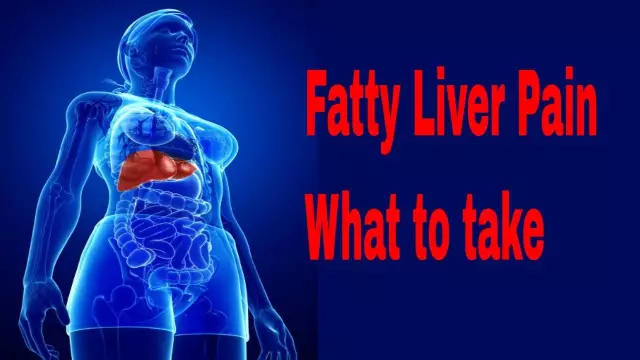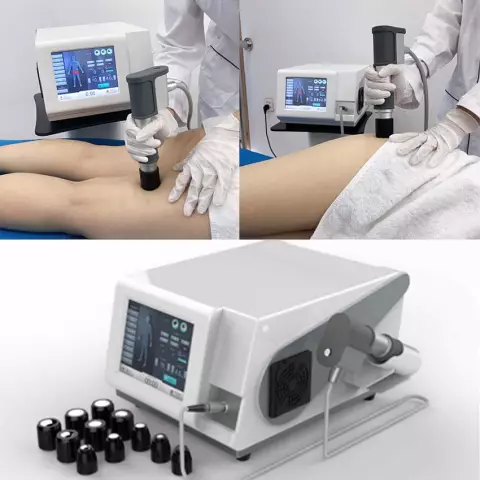- Author Rachel Wainwright [email protected].
- Public 2023-12-15 07:39.
- Last modified 2025-11-02 20:14.
Anaphylactic shock
The content of the article:
- Causes and risk factors
- Forms
- Stages
-
Symptoms
- Mild anaphylactic shock
- Moderate anaphylactic shock
- Severe anaphylactic shock
- Diagnostics
- Treatment
- Consequences and complications
- Forecast
- Prevention
Anaphylactic shock is an acute allergic process that develops in a sensitized body in response to repeated contact with an allergen and is accompanied by hemodynamic disturbances, leading to circulatory failure and, as a consequence, acute oxygen starvation of vital organs.

Bronchospasm is one of the signs of anaphylactic shock
A sensitized organism is an organism that has previously been in contact with a provocateur and has increased sensitivity to it. In other words, anaphylactic shock, like any other allergic reaction, develops not on the first exposure to the allergen, but on the second or subsequent ones.
Shock is an immediate-type hypersensitivity reaction and is a life-threatening condition. A complete clinical picture of shock unfolds in a period from several seconds to 30 minutes.
For the first time, anaphylactic shock is mentioned in documents dated 2641 BC. e. According to records, the Egyptian pharaoh Menes died from an insect bite.
The first qualified description of the pathological condition was made in 1902 by the French physiologists P. Portier and C. Richet. In the experiment, after repeated immunization, a dog that had previously tolerated serum administration well developed acute shock with a lethal outcome instead of a preventive effect. To describe this phenomenon, the term anaphylaxis was introduced (from the Greek words ana - "reverse" and phylaxis - "protection"). In 1913, these physiologists were awarded the Nobel Prize in Medicine and Physiology.
Data from epidemiological studies indicate that the incidence of anaphylactic shock in the Russian Federation is 1 per 70,000 population per year. In patients with acute allergic diseases, it occurs in 4.5% of cases.
Synonym: anaphylaxis.
Causes and risk factors
Anaphylaxis can be caused by various substances, more often of a protein or polysaccharide nature. Low molecular weight compounds (haptens or incomplete antigens), which acquire allergenic properties when they bind to the host protein, can also provoke the development of a pathological condition.
The main provocateurs of anaphylaxis are as follows.
Medicines (up to 50% of all cases):
- antibacterial drugs (most often natural and semi-synthetic penicillins, sulfonamides, Streptomycin, Levomycetin, tetracyclines);
- protein and polypeptide preparations (vaccines and toxoids, enzyme and hormonal agents, plasma preparations and plasma-substituting solutions);
- some aromatic amines (Hypothiazide, para-aminosalicylic acid, para-aminobenzoic acid, a number of dyes);
- non-steroidal anti-inflammatory drugs (NSAIDs);
- anesthetics (Novocaine, Lidocaine, Trimecaine, etc.);
- radiopaque substances;
- preparations containing iodine;
- vitamins (mostly of group B).

Common causes of anaphylactic shock
The second place in the ability to cause anaphylaxis is occupied by the bites of hymenoptera insects (about 40%).
The third group is food (approximately 10% of cases):
- fish, canned fish, caviar;
- crustaceans;
- cow's milk;
- egg white;
- legumes;
- nuts;
- food additives (sulfites, antioxidants, preservatives, etc.).
The main provocateurs also include medicinal allergens, physical factors and latex products.
Factors that increase the severity of anaphylaxis:
- bronchial asthma;
- diseases of the cardiovascular system;
- therapy with beta-blockers, MAO inhibitors, ACE inhibitors;
- allergy vaccination (specific immunotherapy).
Forms
Anaphylactic shock is classified depending on the clinical manifestations and the nature of the pathological process.
In accordance with the clinical symptoms, the following variants are distinguished:
- typical (mild, moderate and severe);
- hemodynamic (manifestations of circulatory disorders prevail);
- asphyxia (symptoms of acute respiratory failure come to the fore);
- cerebral (neurological manifestations are leading);
- abdominal (symptoms of damage to the abdominal organs prevail);
- fulminant.
By the nature of the course, anaphylactic shock is:
- acute malignant;
- acute benign;
- protracted;
- recurrent;
- abortive.
The International Classification of Diseases of the 10th revision (ICD-10) offers a separate gradation:
- anaphylactic shock, unspecified;
- anaphylactic shock caused by a pathological reaction to food;
- anaphylactic shock associated with the administration of serum;
- anaphylactic shock caused by a pathological reaction to an adequately prescribed and correctly applied drug.
Stages
In the formation and course of anaphylaxis, there are 3 stages:
- Immunological - changes in the immune system that occur when the allergen enters the body for the first time, the formation of antibodies and sensitization itself.
- Pathochemical - release of mediators of an allergic reaction into the systemic circulation.
- Pathophysiological - detailed clinical manifestations.
Symptoms
The time of appearance of clinical signs of shock depends on the method of introducing the allergen into the body: with intravenous administration, the reaction can develop within 10-15 seconds, intramuscularly - after 1-2 minutes, oral - after 20-30 minutes.

Anaphylactic shock symptoms
The symptoms of anaphylaxis are very diverse, however, a number of leading symptoms are determined:
- hypotension, up to vascular collapse;
- bronchospasm;
- spasm of smooth muscles of the gastrointestinal tract;
- stagnation of blood in both arterial and venous links of the circulatory system;
- increased permeability of the vascular wall.
Mild anaphylactic shock
The mild degree of typical anaphylactic shock is characterized by:
- itchy skin;
- headache, dizziness;
- feeling of heat, hot flashes, chills;
- sneezing and discharge of mucus from the nose;
- sore throat;
- bronchospasm with difficult exhalation;
- vomiting, cramping pain in the umbilical region;
- progressive weakness.
Objectively, hyperemia (less often - cyanosis) of the skin, rash of varying severity, hoarseness of the voice, wheezing heard at a distance, a decrease in blood pressure (up to 60/30-50 / 0 mm Hg), a threadlike pulse and tachycardia up to 120- 150 bpm
Moderate anaphylactic shock
Symptoms of moderate anaphylactic shock:
- anxiety, fear of death;
- dizziness;
- heartache;
- diffuse pain in the abdominal cavity;
- indomitable vomiting;
- feeling short of breath, choking.
Objectively: consciousness is depressed, cold sticky sweat, pale skin, cyanotic nasolabial triangle, pupils dilated. Heart sounds are muffled, the pulse is threadlike, arrhythmic, rapid, blood pressure is not determined. Involuntary urination and defecation, tonic and clonic convulsions are possible, rarely bleeding of various localization.
Severe anaphylactic shock
The severe course of anaphylactic shock is characterized by:
- lightning-fast deployment of the clinic (from several seconds to several minutes);
- lack of consciousness.
There are marked cyanosis of the skin and visible mucous membranes, profuse sweat, persistent dilatation of the pupils, tonic-clonic convulsions, wheezing labored breathing with prolonged exhalation, frothy sputum. Heart sounds are not heard, blood pressure and pulsation of peripheral arteries are not detected. The victim, as a rule, does not have time to present complaints due to a sudden loss of consciousness; if you do not provide medical attention immediately, there is a high probability of death.
The severity of anaphylactic shock:
| Light flow | Medium severity | Heavy current | |
| Arterial pressure | Decreases to 90/60 mm Hg. Art. | Decreases to 60/40 mm Hg. Art. | Not determined |
| Period of harbingers | 10-15 minutes | 2-5 minutes | Seconds |
| Loss of consciousness | Short-term fainting | 10-20 minutes | More than 30 minutes |
| Treatment effect | It responds well to treatment | The effect is delayed, long-term observation is required | No effect |
When recovering from anaphylactic shock, the victims show weakness, lethargy, lethargy, severe chills, sometimes fever, muscle and joint pain, headache, stitching pains and discomfort in the heart.
Diagnostics
Diagnosis of anaphylactic shock is not difficult, since the connection of characteristic clinical manifestations with a previous insect bite, eating an allergenic product or using a drug is usually obvious.
Treatment
Shock treatment begins directly at the site of its occurrence, without waiting for the transportation of the victim to the specialized department. The outcome of the shock is determined by the timeliness and adequacy of first aid measures. The patient should be laid down with his legs raised, his head turned to one side.
Careful monitoring of vital signs is required throughout the entire period of treatment and several hours after the shock has subsided, since clinical symptoms can recur within a day.
Principles of therapy for anaphylactic shock:
- immediate cessation of the intake of the allergen (for example, removing the sting of an insect or stopping the administration of the drug);
- relief of acute respiratory and hemodynamic disorders;
- compensation for the developed adrenocortical insufficiency;
- neutralization of allergic mediators of anaphylaxis in the systemic circulation and antigen-antibody bonds;
- maintaining vital functions or carrying out resuscitation measures if necessary;
- normalization of acid-base balance;
- increased total peripheral vascular resistance;
- replenishment of the circulating blood volume.
Hospitalization in the intensive care unit and round-the-clock observation are indicated for patients with moderate or severe anaphylaxis, as well as those living far from medical institutions (since complex treatment continues for 72 hours).

Anaphylactic shock requires timely and adequate medical attention
After discharge, patients with anaphylaxis from insect bites are prescribed specific immunotherapy - a set of measures that reduce the body's sensitivity to the allergen by preventing the development or inhibition of sensitization (developing tolerance to the allergen by sequentially administering its microdoses in increasing concentrations).
Consequences and complications
Possible complications (can develop delayed, up to several weeks):
- allergic myocarditis;
- Quincke's edema;
- recurrent urticaria;
- pulmonary edema;
- myocardial infarction;
- heart failure;
- the development of chronic allergic reactions;
- bronchial asthma;
- hepatitis;
- glomerulonephritis;
- "Shock kidney", "shock lung", "shock liver";
- bleeding of various localization;
- neuritis, diffuse damage to the nervous system, vestibulopathy;
- epilepsy;
- autoimmune diseases.
Up to 40% of patients experience a recurrence of anaphylaxis within the next 2-3 years.
Forecast
With timely emergency care and adequate complex therapy, the prognosis is favorable. It worsens significantly at the beginning of anti-shock measures 30 or more minutes after the development of anaphylactic shock.
Prevention
- Avoid taking medications that have a history of allergic reactions, or others that have cross-allergic activity with them.
- Refrain from treatment with drugs that have a high risk of developing anaphylaxis, especially in patients with allergic diseases.
- Avoid areas with a high probability of contact with insects.
- Refuse perfume and cosmetics with an intense odor.
- Allergy sufferers should have a document indicating the diagnosis with them.
- When conducting an X-ray examination using a radio-opaque substance, the doctor must be warned about the existing allergic anamnesis.
- Patients with a history of allergies are advised to give preference to oral forms of drugs.
- All patients with anaphylactic shock should have an epinephrine emergency kit with them and know how to use it.
YouTube video related to the article:

Olesya Smolnyakova Therapy, clinical pharmacology and pharmacotherapy About the author
Education: higher, 2004 (GOU VPO "Kursk State Medical University"), specialty "General Medicine", qualification "Doctor". 2008-2012 - Postgraduate student of the Department of Clinical Pharmacology, KSMU, Candidate of Medical Sciences (2013, specialty "Pharmacology, Clinical Pharmacology"). 2014-2015 - professional retraining, specialty "Management in education", FSBEI HPE "KSU".
The information is generalized and provided for informational purposes only. At the first sign of illness, see your doctor. Self-medication is hazardous to health!






